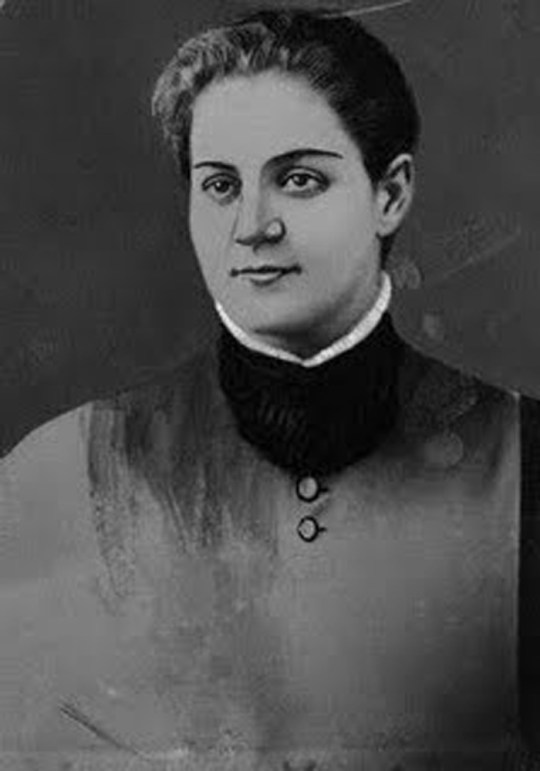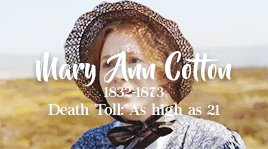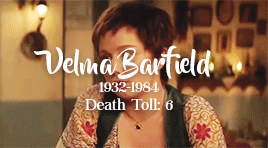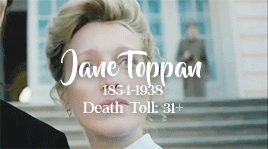#jane toppan
Text
Crazy Killers and Strange Tales
Hello, my Freaky Darlings!
I hope you’ve had a wonderful week. So … let’s get right into it.
Personal Shit
I’m delighted that Sliced and Diced has been unleashed on the world as an audiobook. I’ve wanted to do more with audiobooks for years, but doing more books has been out of my reach for several reasons. But now, thanks to technology, I can do what I’ve always wanted. Don’t you love all the…

View On WordPress
1 note
·
View note
Note
after reading carmilla (1872), I’ve of course become obsessed with how similar she is to lucille. i will not elaborate.
Not going to lie, I don't really see it myself! Let's review known backstory:
turned into a vampire at age 18 by the ghost of someone she knew who had killed themselves
convinced a former friend or lover to hide her from vampire hunters
killed him and escaped
Now she's an eternal teenager whose whole thing is being very sweet and charming on the surface but weirdly intense underneath and okay I maybe see some similarities there (Lucille is about as charming as a dungeon but she does perform social acceptability pretty well)
besides queerness or queercoding, they're also both possessive and motivated by love. and have really nice hair.
so I suppose, upon further reflection, I see it a bit? not massively, but perhaps GDT had some influences from the novel as well as his other sources
(I'm firmly convinced, for example, that the real-life murder cases of Jane Toppan and Constance Kent influenced Lucille's character)
#ask#anon#carmilla#crimson peak#also Laura and Carmilla are technically very distant relatives I suppose#suicide mention
23 notes
·
View notes
Text

Jane Toppan was an American serial killer who confessed to 31 murders. The woman was a nurse and had gotten nicknamed "Jolly Jane" for her friendly and outgoing personality. While the doctors who hired her thought she was one of their best staff members, in reality she made victims of some of her patients and people in their families. Her goal in life was one of the darkest, most twisted ones we've ever heard.
0 notes
Video
youtube
Bloodthirsty Women in History
News of the Times Episode 242 | 1450 - 1905
In 1905, the question is asked in the papers: Are Women more Bloodthirsty Than Men? This news article looks at several ruthless female killers in history and thre crimes they committed including murderers: American Belle Gunness French Jeanne Weber American Jane Toppan French Madame de Brinvilliers Lucretia Borgia Catherine de Medici Kate Bender and more! The question is an interesting one as we have heard from some of our subscribers their understanding that female serial killers were unusual. We have not found this ourselves. A question that still resounds today: Are women more bloodthirsty than men? Is today’s episode of Wicked Wednesdays. We hope you enjoy the show!
Hosted by Robin Coles.
#youtube#historicaltruecrime#historicalcrimedocumentary#victorianmurders#historicalcrimestories#victoriancrimestories#newsofthetimes
1 note
·
View note
Text
0 notes
Text
0 notes
Note
hello there, i came across your blog today and I HAVE TO TELL YOU THIS THAT YOUR NCT DREAM AS VILLAINS AS MY SO SO DOWN BAD, like like it's the most perfect thing dude, so fitting for each of them! you're doing so great! much love <33
thank youuuuuuuuu bro! it was such a random idea that stemmed from my criminal justice course and i was presenting on jane toppan (the serial killer nurse) and i was like oh.... what if jaemin...
but it was really fun to write and i'm glad you liked it 🤗
1 note
·
View note
Text
Events 10.29 (before 1950)
312 – Constantine the Great enters Rome after his victory at the Battle of the Milvian Bridge, stages a grand adventus in the city, and is met with popular jubilation. Maxentius' body is fished out of the Tiber and beheaded.
437 – Valentinian III, Western Roman Emperor, marries Licinia Eudoxia, daughter of his cousin Theodosius II, Eastern Roman Emperor in Constantinople unifying the two branches of the House of Theodosius.
1390 – First trial for witchcraft in Paris leading to the death of three people.
1467 – Battle of Brustem: Charles the Bold defeats Prince-Bishopric of Liège.
1611 – Russian homage to the King of Poland, Sigismund III Vasa.
1618 – English adventurer, writer, and courtier Sir Walter Raleigh is beheaded for allegedly conspiring against James I of England.
1621 – The London Pageant of 1621 celebrates the inauguration of Edward Barkham (Lord Mayor).
1658 – Second Northern War: Naval forces of the Dutch Republic defeat the Swedes in the Battle of the Sound.
1665 – Portuguese forces defeat the Kingdom of Kongo and decapitate King António I of Kongo, also known as Nvita a Nkanga.
1675 – Leibniz makes the first use of the long s (∫) as a symbol of the integral in calculus.
1787 – Mozart's opera Don Giovanni receives its first performance in Prague.
1792 – Mount Hood (Oregon) is named after Samuel Hood, 1st Viscount Hood by Lt. William E. Broughton who sighted the mountain near the mouth of the Willamette River.
1863 – Eighteen countries meet in Geneva and agree to form the International Red Cross.
1863 – American Civil War: Battle of Wauhatchie: Forces under Union General Ulysses S. Grant repel a Confederate attack led by General James Longstreet. Union forces thus open a supply line into Chattanooga, Tennessee.
1888 – The Convention of Constantinople is signed, guaranteeing free maritime passage through the Suez Canal during war and peace.
1901 – In Amherst, Massachusetts, nurse Jane Toppan is arrested for murdering the Davis family of Boston with an overdose of morphine.
1914 – Ottoman entry into World War I.
1918 – The German High Seas Fleet is incapacitated when sailors mutiny, an action which would trigger the German Revolution of 1918–19.
1921 – United States: Second trial of Sacco and Vanzetti in Boston, Massachusetts.
1921 – The Harvard University football team loses to Centre College, ending a 25-game winning streak. This is considered one of the biggest upsets in college football.
1923 – Turkey becomes a republic following the dissolution of the Ottoman Empire.
1929 – Black Tuesday: The New York Stock Exchange crashes, ending the Great Bull Market of the 1920s and beginning the Great Depression.
1941 – The Holocaust: In the Kaunas Ghetto, over 10,000 Jews are shot by German occupiers at the Ninth Fort, a massacre known as the "Great Action".
1942 – The Holocaust: In the United Kingdom, leading clergymen and political figures hold a public meeting to register outrage over Nazi Germany's persecution of Jews.
1944 – The Dutch city of Breda is liberated by 1st Polish Armoured Division.
1944 – World War II: The Soviet Red Army enters Hungary.
1948 – Israeli-Palestinian conflict: Safsaf massacre: Israeli soldiers capture the Palestinian village of Safsaf in the Galilee; afterwards, between 52 and 64 villagers are massacred by the IDF.
0 notes
Text
Show me pictures of serial killers

Show me pictures of serial killers serial#
Dorothea Puente at the Central California Women’s Facility in 2009 (Central California Women’s Facility) Dorothea Puente She pleaded guilty and was sentenced to life imprisonment. She was known as the “Giggling Granny,” the “Lonely Hearts Killer,” the “Black Widow,” and “Lady Blue Beard.” Her main method of murder was rat poison. She is serving a life sentence at Federal Medical Center, Carswell in Fort Worth, Texas.ĭoss killed 11 people between the 1920s and 1954, including four of her husbands, two children, her two sisters, her mother, a grandson, and a mother-in-law. This would cause cardiac arrest, and she would respond to the coded emergency herself. She would inject patients with massive doses of epinephrine, which is an untraceable heart stimulant. Gilbert was a nurse who was convicted of four murders and two attempted murders of patients admitted to the Veterans Affairs Medical Center in Massachusetts. Former Va hospital nurse Kristen Gilbert in an undated yearbook photo (Getty Images) Kristen Gilbert She was tried for murder in 1896 and convicted and hanged.
Show me pictures of serial killers serial#
She worked for 20 years at the “baby farm,” according to the New York Daily News. It is suspected that she killed over 400 infants, which would make her among history’s most prolific serial killers. Amelia Dyer (Public Domain) Amelia Dyerĭyer is only convicted of one murder, but her name is attached to the murder of hundreds of infants and children. She would mix the poison in with her victims’ food while caring for them as a nurse, reports New York Daily News. She killed her parents, her two husbands, her fiancé and her children. She killed 15 people using arsenic, probably between the years 18. Gottfried was a German serial killer who was the last person publicly executed in the city of Bremen. Gesche Gottfried (Public Domain) Gesche Gottfried She was found not guilty by reason of insanity and committed to the Taunton Insane Hospital for life. She would kill the victims with different combinations of medicine and chemicals and even climb into bed with them after administering the dose. Toppan was a nurse who killed dozens of patients, according to NBC. She was nicknamed “Jolly Jane.” She confessed to 31 murders after her arrest in 1901.

0 notes
Text
Jane 'Jolly Jane' Toppan

Jane Toppan was an American serial killer from Massachusetts. She is thought to have had over 31 victims between the years 1895-1901. Toppan is considered an 'Angel of Death,' a type of serial killer who takes on a caring role and murders the vulnerable and dependent.
Jane Toppan's childhood was troubled; her mother died when she was very young and her father was known to be an abusive alcoholic. When Jane was around 6 years old she was left in an orphanage by her father.
In 1885, Toppan began training to be a nurse, she was well-liked and friendly quickly gaining the nickname 'Jolly Jane.' She began experimenting with patient's medication doses out of curiosity about what would happen to them, hiding what she was doing by forging their charts. Toppan was fired from a job for recklessly administering opiates and found work in the private sector.
In 1895, Toppan began her spree of murders by poisoning her landlord and his wife. In 1899 she killer her foster sister. In 1901, Toppan moved in with an elderly male called Alden Davis to take care of him following the death of his wife (who she had also murdered), within weeks him, his sister and two of his daughters were dead. The surviving members of the Davis family called for a toxicology result which found the family had been poisoned. On 29th October 1901, Jane Toppan was arrested, by 1902 she had confessed to 31 murders.
Toppan insisted she was sane and that she knew what she was doing at the time of her crimes, reiterating that she knew her murders were wrong. She stated that she got a sexual thrill from patients being close to death, coming back to life and then dying again, she also stated she had strong orders to poison, even poisoning herself at times to evoke sympathy. A jury, however, found her insane and she was found not guilty by reason of insanity and committed for life to a mental hospital.
#jane toppan#janetoppan#toppan#angel of death#angelofdeath#killer nurse#murder#serial killer#homicide#crime#truecrime#true crime#serialkiller
25 notes
·
View notes
Text
it’s interesting to stumble upon real Victorian murderesses who seem like they may have informed the character of Lucille Sharpe. four immediately come to mind:
- Constance Kent, who killed her young half-brother in 1860, at the age of 16 (apparent motive jealousy for preferential treatment by her parents). she was sent to boarding school in France- a real boarding school, as far as I know, not an asylum -when the investigation fell apart due to her family’s relatively high social status. she turned herself in five years later, though, and served a 20-year prison sentence
- Jane Toppan, a nurse convicted in 1901 of murdering at least 12 patients (though she confessed to 31 killings) with morphine overdoses, apparently for the sexual thrill it gave her
- Belle Gunness, a black widow killer who had a background in butchering animals (that’s the only real similarity here- she faked her own death in 1908 by placing the body of a woman she’d killed in her house and burning it down with her children inside. hardly the Child Escaping Abuse/Woman Killing To Support Her Lover type)
- Lizzie Borden, of course; the quintessential Victorian Patricide Case (may have murdered her father and stepmother with a hatchet, possibly over an inheritance dispute and said father killing her pet doves)
of course, for a fictional sympathetic antagonist, the motives have to have been somewhat nobler (at least at the start). but I do wonder if Del Toro borrowed bits from these women’s stories in creating the character
130 notes
·
View notes
Photo










female serial killers
requested by anonymous & for @aish-rai
#historyedit#history#weloveperioddrama#perioddramaedit#mary ann cotton#elizabeth bathory#clementine barnabet#myra hindley#velma barfield#jane toppan#gesche gottfried#amelia dyer#nannie doss#miyuki ishikawa#20th century#japanese history#british history#american history#19th century#17th century#16th century#hungarian history#our edits#by julia
321 notes
·
View notes
Text
JOLLY JANE - Jane Toppan.
Jane Toppan, or as she would come to be known later in life, 'Jolly Jane', was a Massachusettes serial killer who was active during the late 1800s. To this day it is not known for certain exactly how many victims Jane claimed during her lifetime, but Jane would claim that is was at least 30 victims, with some more sensationalising reports claiming the number to be closer to 100.
Jane was actuary born as Honora Kelley, in Boston in 1854 (or 1857 according to some reports) to Irish immigrants Peter and Bridgette Kelley, though there is little to no information about the family, largely due to their immigrant status. She would come to be known by her family by the nickname of Nora, and she was the youngest of at least three girls, with a sister, Delia, who was two years older, and another older sister called Nellie. Other reports claim that she may have had more siblings than this, but I couldn't find any information about this. When Jane was a few years old, her mother grew sick with a brutal case of tuberculosis, leaving their father to raise the girls. Their father was a tailor, and an aggressive alcoholic who was believed by all those who new him to suffer from some kind of mental illness, which would leave to violent and angry outbursts. This trait would come to earn him a less than kindly nickname 'Kelley the Crack' meaning that he was 'cracked in the head'. It's widely accepted that Jane's early years were extremely miserable, and her and her sister Delia were taken away from the home at the ages of 6 and 8, and sent to the Boston Female Asylum in order to protect them from their increasingly abusive father. I tried to find out what happened to their older sister Nellie, but all I could find for sure was that she was not brought into the orphanage with her siblings because she was too old. It is rumoured that Nellie had actually taken after her father and struggled with mental illness herself until she was eventually committed to an asylum herself. It is also not known for sure what happened to their father, however there was an urban legend that claimed that he actually suffered a severe a severe psychotic break and tried to sew his own eyelids closed.
The Boston Female Asylum, despite the name, was not actually an asylum but an orphanage that had been founded back in 1799 by Hannah Stillman, wife of Revered Samuel Stillman, long before state care for children was invented, and this was actually the first charity set up by women in Boston. Back then it was simply down to the charity of the genourous to provide this kind of home for children, and those running this orphanage were generous enough to provide a home for around 100 girls at the time that Jane and Delia arrived. Jane found a home after around two years in the home, moving in with the Toppan family in 1962. According to reports, Delia was not so lucky and after leaving the orphanage it is rumoured that Delia turned to prostitution in order to survive.
When Jane was placed with the Toppan family, she was not formally adopted, and in fact, she never would be, though this family would be the ones to change her name to Jane, and refer to her as Jane Toppan. Despite being given their name, she would never truly be accepted by the matriarch of the family, due to Ann Toppan's hatred for the Irish. This was also why Jane's name was changed, and using Jane's dark hair and olive skin to her advantage, Ann spread rumours that Jane was Italian rather than admitting the girls Irish roots. However these beliefs didn't spread to her new sister Elizabeth, who was extremely fond of Jane, despite them not being treated equally within the home. Ann Toppan sent Jane to school, where she flourished academically, she was a very bright girl, but was hated by pretty much all of her schoolmates. Jane became known in school for lying about her family, being a snith, blaming other classmates for her own bad behavior and spreading vicious lies and rumours about anyone who would cross her, traits which would continue throughout her life.
Jane was given freedom from the home, along with $50 in cash on her 18th birthday, however she made the decision to stay in the home, working for them as a live in servant for over a decade. During the 70s Ann Toppan passed away and Elizabeth married Deacon Oramel Brigham. Jane was also reportedly engaged at some point during this time, however he left her for another woman, leaving Jane working for her Foster sister the way up to 1885. At this point, Jane decided that she wanted a new challenge and to stand on her own two feet, so she decided, instead of working one of the few menial jobs available to women, she applied to nursing school, and in 1887 she was accepted to Cambridge Hospital in Boston.
Jane used her time in school to reinvent herself, having learnt from her previous schooling how not to behave if you want to make friends. The change in Jane and how she treated people was so drastic at this time that she actually earnt herself the nickname of Jolly Jane. She was working 12 hour days, 7 days a week, getting only two weeks off a year, but she loved it. Her stoicism and bubbly personality earnt her many friends, however her manipulative traits hadn't disappeared. The nurse was still prone to spreading gossip and integrating herself with authority, but she was much alter now. Apparently on at least two occasions during her training Jane's rumours actually cost the nurses their place at the school. She also apparently started committing petty thefts, but nothing ever came of this.
The patients coming through the hospital loved Jane, they found her bright and chatty and genuinely just believed her to be a lovely and bright woman. However it would later be discovered that her relationship with her patients at this time were unusual at best, it became known that Jane had actually been falsifying the medical records of her favourite patients in order to ensure they stayed longer than originally needed. It is also believed that it was around this time that she began given these patients the wrong medication for the same reason, but nobody suspected her of this at the time. The patients that Jane did not care about however, where the elderly, her callous views of them, likely triggered by her uneasy relationship with her elderly foster mother, was that there was 'no use' in keeping them alive. No one at this time could have imagined that she was being serious, but it's hard not to wonder what would have happened if these comments had been taken seriously.
According to Jane, she killed over a dozen people during her time as a student nurse, reportedly using her patients as test subjects by giving her patients varying degrees in order to see the effect which it would have one them. This gradually worsened to the point where Jane would sit and watch her parents suffer, gaining sexual pleasure from this. She even described her feelings while watching her first murder victim die as 'ecstasy'. As is often the case for murderers that operate in hosptials, especially at this time, no one saw her victims death as suspicious, allowing her the freedom to escalate her crimes. As she gained more pharmacological knowledge, she changed her drugs of choice from opiates to a mixture of Atropine 9 and Morphine, since they were much harder to notice. The effects of the drugs counteracted each other in a way that would allow the poisons to go completely unnoticed. By this point she was using her patients as props to improve her own reputation, by nursing her victims back to health when nobody else could.
The reputation that she had built for herself during her training would actually be enough to allow the killer to get a job at Massachusettes General Hospital, and be immediately be put on fast track for promotion once she received her official license. It was once she began working at the hospital that issues would begin to arise for Jane. She quickly got a reputation for taking credit for other people's actions, something which went unnoticed at her previous job, and she also got caught out several times for tampering with medical records, but it was simply put down to incompetence and not malice. However even though the rest of her bad behaviour was being noticed finally, this did not extend to her crimes. Jane was still secretly torturing and killing her patients.
One of her patients survived an attack by Jane, and would reveal in the future, exactly what she remembered. Amelia Phinney recalled being wracked with brutal convulsions when Jane Toppan, her nurse, actually climbed into bed with her, stroking her hair and kissing her cheek and telling her that it would all be okay soon. Amelia recalled that the only reason that she got out of this situation alive was that Jane had been interrupted before giving her a fatal dose. Amelia didn't come forward until after Jane's arrest, since she woke up under the belief that it was nothing more than a dream, and didn't realise otherwise until after Jane's story was revealed.
Despite her difficult relationship with the nurses at her hospital, she managed to grow quite friendly with the doctors at the hospital, mostly due to the fact that she was very intelligent and was technically very good at her job when she was actually doing it. However after being suspected of stealing petty cash from coworkers and patients, and of stealing a nurses diamond ring, she was dismissed from her position in 1890, after she passed her exam, but before receiving her official license.
After working as a private nurse for a short period, Jane decided to return to the much more lenient Cambridge Hospital in an attempt to finally get her license, however Jane's arrogance would get in the way. After an attempt to poison a trainee nurse, Mattie Davis, who will pop up again later on in the story was detected, an investigation was carried out which discovered the large number of patients with similar symptoms that had died while under her care had died. This was once again put down to incompetence and not malice, and Jane was somehow not reported to the police, but was instead fired and blacklisted from hospital work.
With hospital work no longer an option for the serial killer, Jane went back into private nursing, a job which paid far better, but lacked a consistent wage. Working privately also allowed Jane to do pretty much whatever she wanted, since there was no one keeping an eye on her, and no one to report to. Over the next few years Jane would actually go on to become one of the most successful private nurses in Boston.
Israel and Lovey Dunham were an elderly couple whom Jane was boarding with in Wendell Street Cambridge in 1895. Israel was old, and was growing weaker and weaker by the day and Jane, who we know to have very callous opinions of the elderly, decided that the man was 'too old' that he was 'feeble and fussy', and after a short consideration, Jane killed the defenceless man, using her medical training to make it seem as though he had simply had a heart attack. Jane then led his widow Lovey mourn his death for two long years while still living in the home before deciding to also kill the elderly woman. One by one, Jane began killing her way through her elderly patients not seeing 'much point in keeping old people alive'. After killing one of her patients, the family contacted a doctor in town, claiming that they believed Jane to have stolen some clothes from their grandmother's home after her death, but the doctor defended Jane, claiming that she was 'One of the finest women and best nurses that he knew'.
For several years, Jane had been going on holidays to a rented cottage in Cape Cod, which was actually owned by Mattie Davis and her husband, and in August of 1899, Jane decided to extend the invite to her Foster sister Elizabeth. Elizabeth was apparently very excited to see her sister, she was still very fond of Jane, and couldn't wait to spend time with her, but what she didn't know was that Jane had nothing but hate in her heart for Elizabeth. Elizabeth had done nothing to cause this, but Ann Toppan parenting had twisted Jane's mind against Elizabeth, and it had left Jane wanting revenge.
Within days of her arrival in Cape Cod, Elizabeth's husband Oramel received a telegraph from Jane, claiming that Elizabeth had fallen seriously ill. When Oramel finally got to Cape Cod, Elizabeth was in a coma, after suffering a suspected apoplectic stroke, according to the doctor that was called. Tragically, Elizabeth would never recover and she passed away the morning after Oramel arrived.
Not long after her sisters funeral, which she attended despite being the person who killed the innocent woman, Jane decided that it was time to push forward with a scheme which she had been planning for quite some time. The Matron of St John's Theological School at Cambridge, Myra Connors, had been a friend of Jane's for several years now, or at least that was what Myra Connor believed. However, Jane was no friend to Myra, she simply had a plan. Jane wanted Myras job and the apartment, maidservant and regular paycheck that came with it and so, as she had so many times before, poisoned and killed the woman who thought she was her friend. Jane made this murder look like a case of peritonitis that took a tragic turn. At the funeral Jane managed to manipulate her way into the job, but she wouldn't manage to keep it for very long. Jane was not used to being in a position of management, and she had a very lenient attitude towards finances, which would lead to her being asked to resign after just one year.
Jane decided to get away for a while to help soothe her injured ego, so she returned to Mattie and Alden Davis' holiday cottage despite the fact that this was where she had murdered her own frosted sister not too long ago. The kindly couple always gave her a good rate and hadn't charged her for her stay after Elizabeth's death in 1899, and gave her an extension in 1900 since she didn't have enough money to pay it. However when she returned returned to the cottage and left without paying once again again, Mattie took it upon her self to pay the killer a visit in order to confront her in person.
When Mattie went to visit Jane, she was boarding with a new couple, Melvin and Eliza Beedle, she had already poisoned the couple once before, but only enough to make them belive thst they had food poisoning. On Matties arrival Jane poured the woman a glass of water which she laced with morphene, causing Mattie to 'take over poorly'. The Beedle let Mattie rest in one of the homes empty rooms, which allowed Jane to easily top up the dosage without being seen, sending her into a coma. Mattie was diabetic, and when the doctor arrived, Jane told him that Mattie had simply eaten a piece of cake on arrival and that is why she was so unwell. The doctor had no reason to not believe the well known and pretty well respected nurse, and he left Mattie in Jane's care, which would prove to be a tragic and fatal mistake. Jane toyed with Mattie for a week, varying her doses and bringing her in and out of her coma and allowing her moments of panic stricken lucidity, before growing bored and giving the poor woman a fatal dose.
After Matties death, her two daughters, Genevieve and Minnie decided to stay with their grandfather while they came to terms with their grief, and the sweet natured girls made the poor decision to incite Jane to stay with them a while, since they knew and trusted her. For a while, Jane kept herself amused by starting small fires around their their home, and pinning them on a stranger that she had invented, that she claimed to have seen 'skulking about' the property. However, this petty arson wouldn't be enough for her for long. Genevieve had been struggling with her mother's death, she seemed to have not been coping as well as the other members of her family and Jane used this to her advantage. Using her skull for spreading rumours, Jane told Minnie, Matties other daughter, that she had seen her sister sat staring at a tin of arsenic, and suggested that they keep an eye on her, just in case. Jane would go on to poison Genevieve with arsenic, leading her family to believe that she committed suicide.
The use of arsenic in this case was quite an unusual tactic for Jane, heavy metal poisons like arsenic were far too easy to detect for her to normally risk using it, however this time she had built up a story thst would allow her to get away with it. At this time suicides didn't tend to be investigated due to the stigma that surrounded them. Her official cause of death was written as heart disease, but this would not be enough for 'Jolly Jane'. Two weeks after Genevieves death, Jane poisoned her father, Alden, with her usual combination of poisons. His cause of death was officially recorded as grief, and still feeling far too comfortable due to the lack of information, Jane still wasn't done with the family. When Jane gave Minnie her first dose of morphene, it left Minnie unable to swallow, but, determined to finish what she had started she delivered the fatal dose via enema. The doctors were baffled and after struggling to associate her death with anything else, they listed her cause of death as 'exhaustion'.
This string of unexplained deaths within such a short period of time naturally garnered a lot of attention, with several newspapers writing papers about the unusual situation, but people somehow still didn't suspect that the family had been murdered. That is, people other than Minnie's father in law, Captain Paul Gibbs, and Doctor Ira Cushing, who had seen Alden the day before he died. The two men got together and decided that something had to be done about Jane and her suspicious behaviour, and they know who they wanted to contact.
Leonard Wood was the US military governed of Cuba at the time, and he had studied medicine and spent time as a surgeon in the military before joking the officer corps instead. He worked with Tessy Roosevelt to form the famous 'rough riders' that fought in the Spanish - American war, and while Teddy got all the glory for this, it had been at his family home on Cape Cod in 1901, he was payed a visit by family friend Captain Paul Gibbs, and he was asked to use his medical connections and his power to kick start an investigation.
While this investigation was taking place, Jane decided to pay a visit to Revered Oramel Brigham, her sisters widower, welcomed Jane into his home with open arms, but tragically things went off the rails during her short stay. Jane murdered Oramel sister and also proceeded to poison Oramel. Jane nursed Oramel back to health, apparently in an attempt to 'win his affection', however when she was rejected, she calibrated the perfect amount of morphine and took an overdose which, while not fatal, did land her in the hospital. The investigating officer didn't want to let Jane out of his sight so he feigned an illness to be admitted to the hospital alongside her.
Once she discharged she moved onto yet another one of her friends, this time decided to pay a visit to an old friend named Sarah Nichols, however a few weeks after her arrival, Jane was arrested by the police. Luckily for Sarah the police had exhumed the body of Minnie Gibbs and an autopsy finally found evidence of poison.
Jane was actually originally only arrested for Minnie's murder, but as newspapers delved into her background they quickly discovered that this murder was just the start, and they quickly began to push forth rumours about Jane, most of which were untrue.
While the newspapers were free to make whatever judgements they wanted about Jane, the court case would not go quite so smoothly for a few reasons. The first issue faced by the prosecution was the recent death of the Davis families Doctor, since it meant that Jane could make claims about their health without anyone to claim otherwise. And the second issue was that the prosecution were operating under the assumption that Jane had poisoned Minnie with arsenic, however that wasn't the case. The traces of arsenic found on Minnie's body was actually from the embalming fluid that had been used.
It was an interview with Captain Paul Gibbs that would give prosecutors and police the lead they needed. A reporter from the Boston Journal asked Captain Paul for his thoughts kn the arsenic found in the two woman's bodies, he was quick to reveal his surprise. He told the paper "I didn't think Jennie Toppan would use anything as easily detected as arsenic." He knew Jane quite well, and knew how well educated she was, and that she was a much more skilled pharmacologist than people wanted to admit. When asked what he believed that she would have used, and having knowledge on the topic himself, he actually suggested, if you'd believe it, a mixture of morphine and atropine, which as we know was what she had used for the vast majority of her crimes. He also revealed that Jane had owed the family money and that $500 had gone missing from Aldens pocket after his death.
Newspapers dove deep into the past of Jane Toppan, finding out all about her petty thefts and the mysterious deaths, especially thst of Myra Connors. However it was Jeanette Snow, Jane's biological cousin who would give investigators their next big break. Jeanette told them all they wanted to know about Jane's young childhood, especially about 'Kelley the Crack', Jane's father, and Nellie's admittance to an asylum also. Jeanette's information changed the public perception once again, with Jane Toppan no longer seen as an opportunistic poisoned, but as dangerously insane.
Jane's wealthy patients began writing letters in an attempt to help her and for a while it seemed like it might have helped, however this wouldn't last for long. Taking the advice of Captain Paul Gibbs, there was an inquest into Minnie's death where they discovered that she had not been poisoned with arsenic but with morphine and atropine. Investigators had been looking through Jane's finances to find evidence of her purchasing arsenic, and failing to find anything, however, now they were looking into morphine instead they found proof of purchase after purchase of morphine and they finally had the evidence that they needed to take the serial killer to court.
The date was set for Jane's trials, but it did not happen yet. Fred Bixby, Jane's attorney, and the DA agreed to appoint a panel of psychiatrists to examine Jennys mental state and see if she was fit to stand trial. In March of 1902 Dr Henry Stedman, Dr George Jelly and Dr Hosea Quinby began their examination.
While Jane was initially very distrusting of the three doctors, it didn't take long for her chatty personality and her arrogance to show, and she began to open up. The doctors picked up very rapidly on her addiction to lying, but they pushed through, and despite having previously pled guilty, Jane Toppan confessed. The doctors had no idea how twisted Jan was, they were shocked as she discussed, calmly and coldly, thst she had a habit of climbing into bed with her victims, and the sexual thrill that she gained from their death. They had never experienced anything like this before, especially not from a woman. The doctors unanimously declared the serial killer as 'morally insane' which was the term used for psychopathy at the time, and said that she was unfit to stand trial and that she would never recover from her illness.
This was the first time in American history that a serial killer was actually being prosecuted as a serial killer, but the trial was little more than a formality, and a worry free Jane chatted and laughed with her lawyer for the one day that the trial lasted. During the trial Dr Stedman was asked what reason Jane had given for poisoning Minnie Gibbs, to which he simply replied, 'To cause death'. Jane was sentenced to a lifetime in a mental institution the same day.
It wasn't until after the trial took place that it was revealed that Jane had actually confessed to her attorney 6 months earlier when he first began to defend her, and she confessed to more than the 11 murders tbT the police had been investigating. Jane told him that she had been killing for 14 years, and that she had killed at least 31 people. The press went completely wild and every newspaper was reporting all they could about Jolly Jane Toppan.
Jane was sent to Taunton State Hospital, and for the first few years she really enjoyed her stay, and got along really well with all of the doctors and nurses that worked there, but she began to spiral. Jane was diagnosed with Manic Depression and she began to think about using her old name again and becoming a nun. By 1904 she had grown more and more paranoid to the point where she refused to eat anything because, ironically, she believed it to all be poisoned, after 34 years of struggling with worsening mental health issues and paranoia, Jane Toppan died in Taunton in 1938.at 81 years old.
#crime / law / justice#major crimes#murder#murderer#true crime#true facts#murderpedia#Jane Toppan#Jolly Jane#serial killer#american crime
13 notes
·
View notes
Text
¿Te imaginas que la persona que te cuida en el hospital sea en realidad una asesina en serie que disfruta de tu sufrimiento? Esa era la realidad de las víctimas de Jane Toppan, una enfermera que usaba su poder para envenenar y torturar a sus pacientes, amigos y familiares. Jane Toppan confesó haber matado a 31 personas entre 1895 y 1901, pero se cree que pudo haber matado a muchas más. Su ambición era "haber matado a más gente que cualquier otro hombre o mujer que haya existido". ¿Qué la llevó a cometer estos crímenes atroces? ¿Cómo logró escapar de la justicia durante tanto tiempo? ¿Qué pasó con ella después de su arresto? En este video, te contamos la escalofriante historia de Jane Toppan, la enfermera asesina que quería matar más que nadie.
0 notes
Photo

Jane Toppan is one of the first recorded Angels of Death/Mercy, someone in the position of caregiver who abuses that power to harm their patients. During the years 1880 to 1901 Toppan killed at least 31 of her patients, however it is thought that the number could be up to 100. Toppan’s method was administering a lethal dose of morphine intravenously, followed by atropia (to stop muscle spasms) to cover the effects of the former. She claimed that she could not bear to see her patients suffering, but as she also poisoned her landlords and foster sister, this seemed likely to be untrue. Regardless in 1902, Jane Toppan was declared insane and was incarcerated until she died In Taunton State Asylum of natural causes in 1938.
#murder#killer#serial killer#angel of death#angel of mercy#nurse#medical#true crime#tcc blog#jane toppan#carnivalus writes
5 notes
·
View notes
